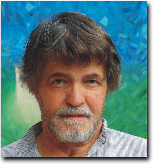
|
ARNÓTI andrás |
biography
| Born in Budapest on November 11, 1949 |
| Civil name: Zoltán Sárközi |
| His master: Mihály Mészáros |
| 1970-1974: | Art School |
| 1974: | graduates in Debrecen, on the faculty of public education and library |
| 1974-1976: | guest visitor at ELTE (the university of liberal arts in Budapest) on the faculty of the history of arts Studies at the Greek philology faculty of ELTE |
| 1984-1995: | lives in Budapest and Cyprus |
| 1983-1986: | art director of the Young Artists Studio Hungarian Art Foundation |
| 1983-1992: | participates in the work of the colony of artists in Nagyatád, Dunaújváros, Sopron and Salgótarján |
| 1989-1992: | journalist, arteditor Art Magazin, Pesti Hírlap |
| 1994-1998: | teacher of painting, Art University Szarvas |
| 1995-2002: | Co-chairman Painting Division, Hungarian Association of Fine Artist |
| 2005-: | guest teacher of Budapest University of Technology and Economics (color-study and workshop) |
| In the eighties and nineties he published several literary, theoretical and publicistic works. Writings on him describe him as a “collector of art genres”. In the background of his pictorial art the occurrence, i.e. the clear epic concentration behind his abstractions, is always present. He is an artist with ideas whose important – nearly compulsory – target is the accuracy of the message, the autonomy of the opinion handled with modesty and playfulness. Compared to his earlier works, as of the mid-nineties he starts to minimize his canvases; mostly it is about the system of relations of two or three (mostly actual) forms with attractive picturesque methods. He handles attractivity and decorativeness as a not negligible and first of all not as a pictorial problem. As one of the explanations to that in the last years he likes to use other types of materials too. At the beginning this was the metal; one of the examples for that is his large-sized work erected in a public place (in Nagykőrös), the “Cityflat” in 1994, later on his picture-like but three dimension marble-series or the glass (“San atout” in 2001, “In memoriam V.L.” in 1999) but also his textile-plaited works belong to this category, the clear motive-order of which comes back on his panel-pictures too (“XXth century” in 1995, “History” in 1995, “Synthesized in points” in 1991). The reduction seen already on his canvases is in the case of these materials even more articulated, his research subject, the analysis of the relation of the part and entirety is even more intensive. As V. Éva Bálint said:”… “Every Whole lies broken/ Every flame burns in parts/ Every love is in pieces” (Endre Ady). In Arnóti’s paintings the absence of the whole in not irreparable – in fact, the absence is irrelevant. The part stands on its own; the composition carves out its own boundaries. As naturally, as a large-scale map in which the whole becomes just one detail…” Arnóti’s painting is touched by the European expressionism, then leaving behind its depressing atmosphere (Prague I.”, “Prague II.”- 2003, “In memoriam P.S”.-2001) the music: jazz and especially the classical music of the 19th and of the first part of the 20th century (“Wagner cycle”-1992-98, “The concert of Mihály Dresch and Archie Shepp in the Spinnery in March 2003”) and the philosophical science history. This last one means in many cases the pictorial analysis of factual problems which – due to its meditative temper – will be completed with other many-sided genres of art mentioned earlier (“Window opening inwards” – 1995, “The road forgotten” -1993, “Hungarian mandala” – 1994, “Two of them” – 1991, “Lyric geometry”- 2002). He wrote in his biography in 2003: “…The most I could do was that I was silent. We looked into the face of each other like two guiltless fighters. The one and a half - two hours waiting in the lobby set off explosive neurotic and mental feelings in the clients. Hardly believable, the pressure started to ease slowly. Sentences started to get organized, controlled, the self-evaluation of those gradually realizing the armchair comfort increased in line with the improving quality of the shaping of characters. A monodrama. I could not interrupt this atmosphere. The only opportunity that was left over for me was to use the pictorial art. I tried to form words into pictures. The stuff of the act in the list turned up: the soaked ceiling, the broken drive-pipe, the lifted flouring. Colours found me with the harmony of the home and with the genres beyond the harmony of the home. And, as a sketch, the curious mystery of believable and unbelievable opened up in front of me but not against my will, my duty, however was not to state genuineness but to cure the trouble somehow, and now, thirty years later on, I can state my duty was to listen, to hark to them, to feel a silent sympathy in some cases, but anyway, to feel empathy. Each story provoked me, more and more new pictures were born and without any request, only by listening, I was introduced into the most hidden secrets. Ever since I make my living by that. By listening, observing in this ever-noisy word. I can go close to everything and everybody, I may touch their objects. They know, I won’t give away their secrets, I will keep them. For them. This is my magic realism, permeance, performance, and minimal art. Everything.” |